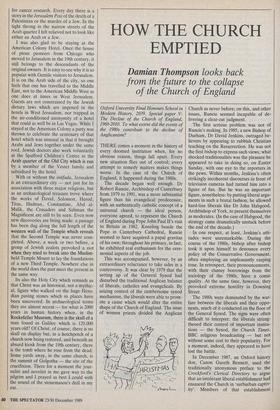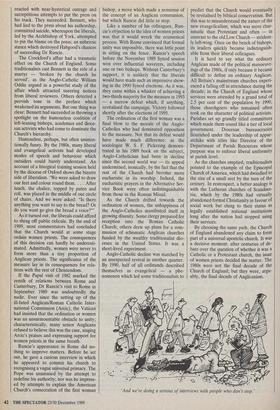HOW THE CHURCH EMPTIED
Damian Thompson looks back
from the future to the collapse of the Church of England
Oxford University Final Honours School in Modern History, 2039. Special paper V: The Decline of the Church of England, 1960-2010. To what extent did the events of the 1980s contribute to the decline of Anglicanism?
THERE comes a moment in the history of every doomed institution when, for no obvious reason, things fall apart. Every new situation flies out of control; every attempt to remedy matters makes things worse. In the case of the Church of England, it happened during the 1980s.
The decade began well enough. Dr Robert Runcie, Archbishop of Canterbury from 1979 to 1991, was a more substantial figure than his evangelical predecessor, with an authentically catholic concept of a universal church — the ideal person, everyone agreed, to represent the Church of England during Pope John Paul II's visit to Britain in 1982. Kneeling beside the Pope in Canterbury Cathedral, Runcie seemed to have acquired a papal gravitas of his own; throughout his primacy, in fact, he exhibited real enthusiasm for the cere- monial aspects of the job.
This was accompanied, however, by an extraordinary reluctance to take sides in a controversy. It was clear by 1979 that the setting up of the General Synod had disturbed the traditional Anglican balance of liberals, catholics and evangelicals. By seizing control of the cumbersome synod mechanism, the liberals were able to prom- ote a cause which would alter the entire shape of the Church of England. The issue of women priests divided the Anglican Church as never before; on this, and other issues, Runcie seemed incapable of de- livering a clear-cut judgment.
The first serious problem was not of Runcie's making. In 1985, a new Bishop of Durham, Dr David Jenkins, outraged be- lievers by appearing to rubbish Christian teaching on the Resurrection. He was not the first bishop to express such views; what shocked traditionalists was the pleasure he appeared to take in doing so, on Easter Sunday, with one eye to the reporters in the pews. Within months, Jenkins's often strikingly incoherent discourses in front of television cameras had turned him into a figure of fun. But he was an important figure, nonetheless: by putting liberal argu- ments in such a brutal fashion, he allowed hard-line liberals like Dr John Habgood, Archbishop of York, to present themselves as moderates. (In the case of Habgood, the strategy came dramatically unstuck before the end of the decade.) In one respect, at least, Jenkins's atti- tudes were unremarkable. During the course of the 1980s, bishop after bishop took it upon himself to denounce every policy of the Conservative Government, often employing an unpleasantly carping tone. In retrospect, their pronouncements, with their clumsy borrowings from the sociology of the 1960s, have a comic quality. At the same time, however, they provoked extreme hostility in Downing Street.
The 1980s were dominated by the war- fare between the liberals and their oppo- nents, much of it conducted on the floor of the General Synod. The signs were often difficult to interpret: the liberals streng- thened their control of important institu- tions — the Synod, the Church Times, BBC religious broadcasting — but not without some cost to their popularity. For a moment, indeed, they appeared to have lost the battle.
In December 1987, an Oxford history don, Canon Gareth Bennett, used the traditionally anonymous preface to the Crockford's Clerical Directory to argue that an intolerant liberal establishment had ensnared the Church in `surburban captiv- ity'. Members of that establishment reacted with near-hysterical outrage and surreptitious attempts to put the press on his track. They succeeded. Bennett, who had lied to the press about his authorship, committed suicide, whereupon the liberals, led by the Archbishop of York, attempted to pin the blame on the press; an unheroic stance which destroyed Habgood's chances of succeeding Dr Runcie.
The Crockford's affair had a traumatic effect on the Church of England. Some traditionalists cast Bennett in the role of a martyr — 'broken by the church he served', as the Anglo-Catholic William Oddie argued in a powerful study of the affair which attracted sneering notices from liberal reviewers. Others detected a peevish tone in the preface which weakened its arguments. But one thing was clear: Bennett had succeeded in throwing a spotlight on the humourless coalition of left-leaning bishops, academics and dioce- san activists who had come to dominate the Church's hierarchy.
Humourless, perhaps, but often uninten- tionally funny. By the 1980s, many liberal and evangelical activists had developed modes of speech and behaviour which outsiders could barely understand. An account of a liturgical training session held by the diocese of Oxford shows the bizarre side of liberalism. 'We were asked to draw our feet and colour round them. . . . After lunch, the chalice, topped by paten and roll, was placed in the middle of our circle of chairs. And we were asked: "Is there anything you want to say to the bread? Or do you want go give the bread a voice?"' As it turned out, the liberals could afford to shrug off public ridicule. By the end of 1989, most commentators had concluded that the Church would at some stage ordain women priests. The consequences of this decision can hardly be underesti- mated. Admittedly, women were never to form more than a tiny proportion of Anglican priests. The significance of the measure lay in its consequences for rela- tions with the rest of Christendom.
If the Papal visit of 1982 marked the zenith of relations between Rome and Canterbury, Dr Runcie's visit to Rome in September 1989 was undoubtedly the nadir. Ever since the setting up of the ill-fated Anglican/Roman Catholic Inter- national Commission (Arcic), the Vatican had insisted that the ordination or women was an unsurmountable obstacle to unity; characteristically, many senior Anglicans refused to believe this was the case, singing Arcic's praises and expressing support for women priests in the same breath.
Runcie's appearance in Rome did no- thing to improve matters. Before he set out, he gave a curious interview in which he appeared to commit his church to recognising a vague universal primacy. The Pope was unamused by the attempt to redefine his authority; nor was he impress- ed by attempts to explain the American Church's consecration of the first woman bishop, a move which made a nonsense of the concept of an Anglican communion, but which Runcie did little to stop.
Like a number of his colleagues, Run- cie's objection to the idea of women priests was that it would wreck the ecumenical process. With Rome convinced that formal unity was impossible, there was little point in sitting on the fence. Runcie's speech before the November 1989 Synod session won over influential waverers, including one or two bishops. Without Canterbury's support, it is unlikely that the liberals would have made such an impressive show- ing in the 1990 Synod elections. As it was, they came within a whisker of achieving a two-thirds majority for the measure in 1993 — a narrow defeat which, if anything, revitalised the campaign. Victory followed shortly after the elections of 1995.
The ordination of the first woman was a final blow to the morale of the Anglo- Catholics who had dominated opposition to the measure. Not that its defeat would have made much difference: as the sociologist W. S. F. Pickering demons- trated in his 1989 book on the subject, Anglo-Catholicism had been in decline since the second world war — its appeal undermined, ironically, by the fact that the rest of the Church had becofne more eucharistic in its worship. Indeed, the eucharistic prayers in the Alternative Ser- vice Book were often indistinguishable from those in the Roman Missal.
As the Church drifted towards the ordination of women, the unhappiness of the Anglo-Catholics manifested itself in growing disunity. Some clergy prepared for reception into the Roman Catholic Church; others drew up plans for a com- munion of schismatic Anglican churches funded by the wealthy traditionalist dio- ceses in the United States. It was a short-lived experiment.
Anglo-Catholic decline was matched by an unexpected revival in another quarter. By 1990, half of all ordinands described themselves as evangelical — a phe- nomenon which led some traditionalists to predict that the Church would eventually be revitalised by biblical conservatism. But this was to misunderstand the nature of the new evangelicalism, which was more char- ismatic than Protestant and often — m contrast to the old Low Church — strident- ly left-wing. Once on the bench of bishops, its leaders quickly became indistinguish- able from their liberal colleagues.
It is hard to say what the ordinary Anglican made of the political manoeuvr- ings of the 1980s, if only because it became difficult to define an ordinary Anglican. All Britain's mainstream churches experi- enced a falling off in attendance during the decade; in the Church of England whose services were attended by a grand total of 2.5 per cent of the population by 1990, those churchgoers who remained often took on the character of political activists. Parishes set up grandly titled committees which made them sound like a tier of local government. Diocesan bureaucracies flourished under the leadership of appar- atchiks with titles like Director of the Department of Parish Resources whose purpose was to enforce liberal uniformity at parish level.
As the churches emptied, traditionalists pointed to the example of the Episcopal Church of America, which had dwindled to the size of a small sect by the turn of the century. In restrospect, a better analogy is with the Lutheran churches of Scandina- via, which by the 1980s had virtually abandoned formal Christianity in favour of social work but clung to their status as legally established national institutions long after the nation had stopped using their services.
By choosing the same path, the Church of England abandoned any claim to form part of a universal apostolic church. It was a decisive moment: after centuries of de- bate over the question of whether it was a Catholic or a Protestant church, the issue of women priests decided the matter. The 1980s were not the final decade of the Church of England; but they were, argu- ably, the final decade of Anglicanism.
And we're doing a serious of interviews with people who don't stop.'











































































































 Previous page
Previous page